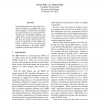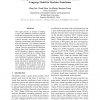115
click to vote
ACL
2012
13 years 2 months ago
2012
Bayesian approaches have been shown to reduce the amount of overfitting that occurs when running the EM algorithm, by placing prior probabilities on the model parameters. We appl...
ACL
2012
13 years 2 months ago
2012
We propose a novel heuristic algorithm for Cube Pruning running in linear time in the beam size. Empirically, we show a gain in running time of a standard machine translation syst...
124
click to vote
EMNLP
2011
14 years 1 days ago
2011
We propose a simple training regime that can improve the extrinsic performance of a parser, given only a corpus of sentences and a way to automatically evaluate the extrinsic qual...
102
click to vote
ACL
2011
14 years 3 months ago
2011
Machine Translation in India is relatively young. The earliest efforts date from the late 80s and early 90s. The success of every system is judged from its evaluation experimental...
101
click to vote
ACL
2011
14 years 3 months ago
2011
This paper presents an attempt at building a large scale distributed composite language model that simultaneously accounts for local word lexical information, mid-range sentence s...
COLING
1996
15 years 1 months ago
1996
Pattern-based machine translation systems can be easily customized by adding new patterns. To gain full profits from this character, input of patterns should be both expressive an...
105
click to vote
COLING
1994
15 years 1 months ago
1994
This paper presents a brief overview of the bidirectional (Japanese and English) TransferDriven Machine Translation system, currently being developed at ATR. The aim of this devel...
109
click to vote
COLING
1994
15 years 1 months ago
1994
In an interlingual knowledge-based machine translation system, ambiguity arises when the source language analyzer produces more than one interlingua expression for a source senten...
119
click to vote
ANLP
1994
15 years 1 months ago
1994
This paper presents a practical machine translation system based on sentence types for economic news stories. Conventional English-to-Japanese machine translation (MT) systems whi...
114
click to vote
ANLP
1997
15 years 1 months ago
1997
Identifying the occurrences of proper names in text and the entities they refer to can be a difficult task because of the manyto-many mapping between names and their referents. We...


